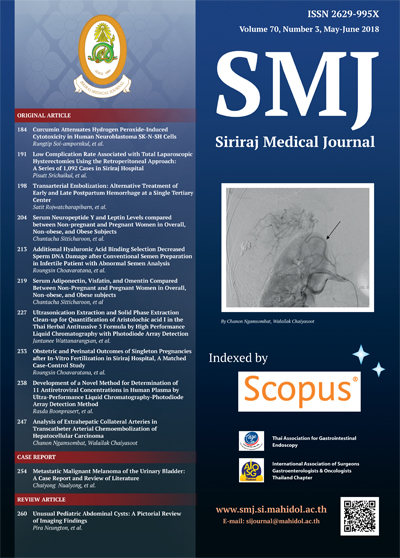Analysis of Extrahepatic Collateral Arteries in Transcatheter Arterial Chemoembolization of Hepatocellular Carcinoma
Keywords:
Extrahepatic collateral arteries; hepatocellular carcinomaAbstract
Objective: Development of extrahepatic collateral arteries (ECAs) supply to hepatocellular carcinoma (HCC) can interfere effective control of tumor by transcatheter arterial chemoembolization (TACE) treatment. The aim of
this study is to analyze the prevalence and causative factors of ECAs to HCC and complications of TACE through each ECAs.
Methods: We performed a retrospective review of total 1,374 procedures from 639 patients with a diagnosis of HCC who were sent for TACE (range from 1 - 16 sessions, mean = 2.87 sessions) from January 2008 - May 2010.
Prevalence, causative factors such as size and location of the tumor and previous treatment were analyzed.
Results: There are 122 (19.09%) from 639 patients that showed ECAs supplying the tumors. The prevalence of ECAs to HCC was 34.39% from right inferior phrenic artery, 30.68% from omental artery, 9.52% from left
gastric artery, 5.82% from left inferior phrenic artery, 5.29% from colic branch of superior mesenteric artery (SMA) and 4.23% from intercostal artery. Statistical analysis showed that tumor size of more than 8-10 cm and
location at hepatic surface, especially liver bare area were significantly associated with the presence of ECAs (p<0.01). The cumulative probability of ECAs formation increases with a number of the sessions of TACE.
Conclusion: Our observation indicates that the factors which could influence ECAs formation included tumor size of more than 8-10 cm and tumor location at surface area, especially liver bare area. As the number of TACE
sessions increased, the cumulative probability of the presence of ECAs also increased. TACE through the ECAs is a relatively safe procedure. To recognize and get familiar with the presence of ECAs to HCC are essential to improve treatment outcome of the patients.
Downloads
Published
How to Cite
Issue
Section
License
Authors who publish with this journal agree to the following conditions:
Copyright Transfer
In submitting a manuscript, the authors acknowledge that the work will become the copyrighted property of Siriraj Medical Journal upon publication.
License
Articles are licensed under a Creative Commons Attribution-NonCommercial-NoDerivatives 4.0 International License (CC BY-NC-ND 4.0). This license allows for the sharing of the work for non-commercial purposes with proper attribution to the authors and the journal. However, it does not permit modifications or the creation of derivative works.
Sharing and Access
Authors are encouraged to share their article on their personal or institutional websites and through other non-commercial platforms. Doing so can increase readership and citations.











